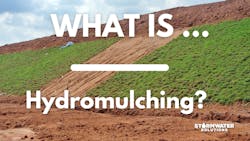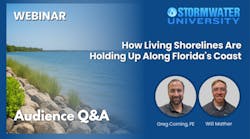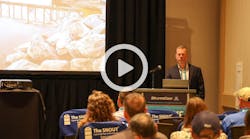What is hydromulching?
Hydromulching, or hydroseeding, is a treatment of land which involves spraying a combination of seed, fiber, tackifier and other materials to an area.
A typical application of hydromulching would be something along the lines of a local grass seed combined with fiber, such as compost. The seed and fiber would be pre-mixed with a tackifier to increase the stickiness of the spray. Other materials, such as fertilizer, may be included in the mix.
The hydromulch mix would then be sprayed out of a hydraulic spray rig on to disturbed soils.
Hydromulching is ideal for cut and fill slopes 2:1 (H:V) and flatter, as well as on disturbed areas larger than 0.5 acres.
Benefits of hydromulching include protecting soil surface from erosion due to raindrop impact and conserving water/soil mixture. Other benefits are a low initial cost compared to other treatments and the long-term erosion control provided by vegetation from seeding.
What are the limitations of hydromulching?
Hydromulching is for surface treatment only. It does not improve underlying soil structure, improve soil biome, restore nutrients, sufficiently improve compacted soils and does not always result in sufficient vegetative cover.
Higher application rates of hydromulching required for steeper slopes may inhibit seed germination and long-term establishment of vegetation. It’s also not efficient in treating disturbed areas less than 0.5 acres.
Utilizing netting or turf reinforcement mat may help the seeds better stick in place on sites with poor soils or high grades. Using local topsoil, a compost blanket, incorporating compost or roughening soil surface can better help the seed stick.[1]
Benefits of hydromulching
Hydromulching offers many benefits including easy installation, no tenting, environmentally friendly, savings, effectiveness and safety.
Hydromulching can be easily installed after rough the rough grading of land. Hydroseeding crews can spray the hydromulch from specially equipped trucks without damage to the surrounding area.
The high-pressure spray makes installation quick and relatively easy given the alternatives, like erosion control blankets.
Erosion control blankets use netting to keep everything in place. Stronger plants can push against the netting, resulting in a “tenting” effect. Tenting pulls the nutrient-rich mulch away from the seeds that are still growing.
The netting can prevent plants from growing and create a trap for small animals, damaging the local environment.
Hydromulch is safe for plants and animals because it uses a nontoxic mix that integrates into the local environment.
Hydro seeding is less time-consuming than installing erosion control blankets. An easier process means fewer laborers and a faster setup, resulting in smaller installation costs.
In order to install an erosion control blanket, the land it overs must be smooth to maximize the contact between the ground and the blanket. The result is migrating seeds and soil shift which creates spotty coverage.
Hydromulching allows the seed to be sprayed on rough terrain and ensures that the seeds take root where intended.
Hydromulching is intended to be a safe solution as well. Rather than have workers climb steep slopes to install blankets and nets, they can man a truck that sprays the seeds onto the ground.[2]
What is in hydromulch?
The hydroseed is a slurry mixture composed of water, seed, fertilizer, cellulosic mulch, tracking dye, and a binder/tackifier to help it stick to the ground.
A specially designed hydroseed truck keeps the mixture continuously agitated during the application, which ensures an even and uniform application.
A cannon, also known as a boom, may alternatively be used to apply the slurry mixture, when the type of terrain calls for it. A cannon is capable of spraying mixture to over 100 meters more than typical hydroseeders, which is ideal in accessing areas that are difficult to reach.[3]
What are the different types of hydromulch?
A benefit to hydromulching is the ability to tailor the mixtures to local vegetation and climates. The types of seeds can be changed to match local ecosystems and different fertilizers and dyes could be used in tandem with the seeds.
Different types of mulch can also be used such as wood fiber mulch, blended mulch and paper mulch.
These mulches can also contain other ingredients like synthetic fibers and sawdust to help it perform better.
The different ingredients also share different cost points. All of this can be utilized to meet different local needs such as budget, climate and local vegetation.[4]
Sources
[1] https://calrecycle.ca.gov/organics/compostmulch/toolbox/hydroseed/
[2] https://www.superiorgroundcover.com/hydromulch-best-groundcover-erosion-control/
[3] https://www.erizon.com.au/what-is-hydromulching/#:~:text=Hydromulching%20is%20a%20vegetation%20process,fast%2C%20economical%20and%20efficient%20revegetation.
[4] https://www.superiorgroundcover.com/hydroseeding-101/
About the Author
Alex Cossin
Associate Editor
Alex Cossin is the associate editor for Waterworld Magazine, Wastewater Digest and Stormwater Solutions, which compose the Endeavor Business Media Water Group. Cossin graduated from Kent State University in 2018 with a Bachelor of Science in Journalism. Cossin can be reached at [email protected].



